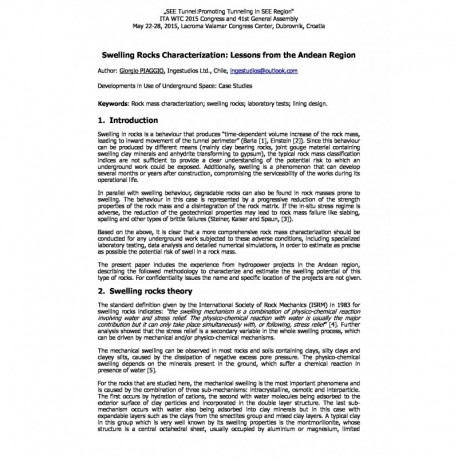Cart
0
0
No document
0,00 €
Total
Document successfully added to your shopping cart
Quantity
Total
There are 0 items in your cart.
There is 1 item in your cart.
Total documents
Total shipping
To be determined
Total
Search & filter
Search for a publication
Search & filter
Viewed documents
Swelling Rocks Characterization: Lessons from the Andean Region
wtc2015_full_piaggio
Swelling in rocks is a behaviour that produces “time-dependent volume increase of the rock mass, leading to inward movement of the tunnel perimeter” (Barla [1], Einstein [2]). Since this behaviour can be produced by different means (mainly clay bearing rocks, joint gouge material containing swelling clay minerals and anhydrite transforming to gypsum), the typical rock mass classification indices are not sufficient to provide a clear understanding of the potential risk to which an underground work could be exposed. Additionally, swelling is a phenomenon that can develop several months or years after construction, compromising the serviceability of the works during its operational life. In parallel with swelling behaviour, degradable rocks can also be found in rock masses prone to swelling. The behaviour in this case is represented by a progressive reduction of the strength properties of the rock mass and a disintegration of the rock matrix. If the in-situ stress regime is adverse, the reduction of the geotechnical properties may lead to rock mass failure like slabing, spalling and other types of brittle failures (Steiner, Kaiser and Spaun, [3]). Based on the above, it is clear that a more comprehensive rock mass characterization should be conducted for any underground work subjected to these adverse conditions, including specialized laboratory testing, data analysis and detailed numerical simulations, in order to estimate as precise as possible the potential risk of swell in a rock mass. The present paper includes the experience from hydropower projects in the Andean region, describing the followed methodology to characterize and estimate the swelling potential of this type of rocks. For confidentiality issues the name and specific location of the projects are not given.




